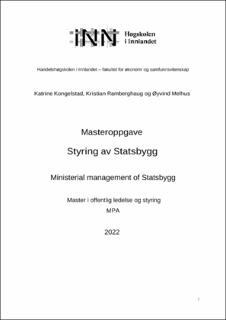| dc.contributor.advisor | | |
| dc.contributor.author | Katrine Kongelstad, Kristian Ramberghaug og Øyvind Melhus | |
| dc.date.accessioned | 2023-04-24T16:12:42Z | |
| dc.date.issued | 2022 | |
| dc.identifier | no.inn:inspera:110525064:52133405 | |
| dc.identifier.uri | https://hdl.handle.net/11250/3064700 | |
| dc.description.abstract | Bakgrunn: Begrepet styring brukes svært bredt i det politiske og offentlige ordskiftet. Vi har i de senere år sett dette ofte i media og deres omtale rundt dårlig styring av offentlige prosjekter. Denne studien tar dermed for seg den offentlige etatsstyringen av etaten Statsbygg. Målsettingen med studien har blant annet vært å se hvordan departementet styrer etaten.
Problemstilling: Oppgavens problemstilling er som følger: Hvordan styrer Kommunal- og moderniseringsdepartementet Statsbygg?
I tillegg til denne problemstillingen, presenterer studien et sett med forventninger til hvilke funn som det var antatt at man ville finne. Disse forventningene var koblet mot ulike styringsmodeller, og studien utforsker problemstillingen gjennom disse ulike styringsmodellene.
Teoretisk grunnlag: Det teoretiske grunnlaget for studien baserer seg på teorier rundt styring og kontroll. Studien avgrenser dette primært til styringsmodellen Andersen og Pors fremstiller i sin bok “Velfærdsledelse” og styringsmodellen som presenteres av Osborne, Torfing og Triantafillo. Studien ser også gjennom teorien på opptakten til statlig styring i Norge og hvordan denne blant annet er påvirket av utenlandske trender.
Forskningsdesign: Denne studien har valgt et teoretisk fortolkende casedesign. Det ble benyttet en kvalitativ tilnærming til innsamling av data gjennom dokumentanalyse. I tillegg er det i studien gjennomført semistrukturerte intervjuer av respondenter fra Kommunal- og moderniseringsdepartemenet, forvaltningen og etaten Statsbygg. Studien har valgt å forholde seg til den øverste ledelse både i departementet, forvaltningen og i etaten. Dette har bidratt til en bredere og mer nyansert slutning på problemstillingen gjennom analysen og drøftingen i studien.
Resultater og funn: Som en forvaltningsbedrift i Staten med budsjettfullmakter, er det naturlig å anta at Statsbygg i utgangspunktet skal ha relativt stor autonomi og selvstyring. Med de avgrensingene som er presentert for denne studien, og de dokumentene som er lagt til grunn, peker studiens funn på det motsatte. Våre funn peker i retning av at styringsdialogen bærer preg av sterk departemental styring av Statsbygg. | |
| dc.description.abstract | Background: The concept of governance is used very broadly in the political and public discourse. In recent years, we have seen this often in the media and their mention of poor management of public projects. This study thus addresses the public agency management of Statsbygg. The objective of the study has, among other things, been to see how the Ministry manages the agency.
Research question: The problem of the thesis is as follows: How does the Ministry of Local Government and Modernisation manage Statsbygg?
In addition to this research question, the study presents a set of expectations as to which findings were thought to be found. These expectations were linked to different management models, and the study explores the problem through these different models.
Theoretichal framework: The theoretical basis for the study is based on theories of governance and control. The study delineates this primarily to the governance model presented by Andersen and Pors in their book "Velfærdsledelse" and the governance model presented by Osborne, Torfing and Triantafillo. The study also looks at the theory of state governance in Norway, and how this is influenced, among other things, by foreign trends.
Research design: This study has chosen a theoretical interpretive case design. A qualitative approach was used to collect data through document analysis. In addition, semi-structured interviews have been conducted in the study by respondents from the Ministry of Local Government and Modernisation, the public administration and Statsbygg. The study has chosen to deal with the top management in the Ministry, the public administration and the agency. This has contributed to a broader and more nuanced conclusion to the problem through the analysis and discussion in the study.
Results and findings: As a management company in the State with budgetary powers, it is natural to assume that Statsbygg should have relatively high autonomy and self-management, in principle. With the delimitations presented for this study, and the documents used as a basis, the study's findings point to the opposite. Our findings indicate that the management dialogue is characterised by strong ministryal management of Statsbygg. | |
| dc.language | nob | |
| dc.publisher | Inland Norway University | |
| dc.title | Styring av Statsbygg | |
| dc.type | Master thesis | |
